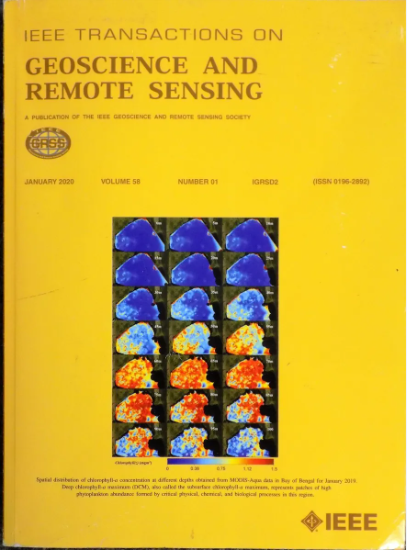Monitoring Rice Leaf Nitrogen Content Based on the Canopy Structure Effect Corrected With a Novel Model PROSPECT-P
IF 7.5
1区 地球科学
Q1 ENGINEERING, ELECTRICAL & ELECTRONIC
IEEE Transactions on Geoscience and Remote Sensing
Pub Date : 2024-09-17
DOI:10.1109/TGRS.2024.3462766
引用次数: 0
Abstract
Spectral remote sensing can effectively, rapidly, and nondestructively detect the nitrogen status of crop plants. Estimation of crop leaf nitrogen concentration (LNC, %) using canopy bidirectional reflectance factor (BRF) is an effective method to diagnose nitrogen deficiency in crops. It is challenging to estimate LNC with empirical remote sensing models because the variability of the canopy structure at different growth stages affects the model accuracy. Over the years, the canopy scattering coefficient [CSC, the ratio of BRF to directional area scattering factor (DASF)] has been used for LNC estimation by suppressing the effect of the canopy structure on BRF. However, this method often regards leaves as the main factor and has less consideration for the canopy structure effects on BRF caused by other organs (e.g., panicles). Incorporating the changes with the emergence of rice panicles into the DASF algorithm may generate reliable results in LNC estimation. Herein, we propose the PROSPECT-P model, which is based on the PROSPECT model and combines the panicle spectra to quantify the structural properties of the panicles and realize the simulation of the panicle albedo at different growth stages. Utilizing the spectral invariants theory, a panicle-leaf structure correction factor (DASFLP) was calculated based on canopy BRF, panicle albedo, leaf albedo, and canopy component fraction. CSC after correction for panicle and leaf structure (CSCLP) from 400–2500 nm can be obtained by the ratio of BRF and DASFLP. The CSCLP was further subjected to continuous wavelet analysis (CWA) and achieved an accurate estimation of the LNC using four machine learning (ML) models. The results showed that when combined with eight wavelet features (WFs), CSCLP can accurately invert rice LNC using the random forest algorithm (基于利用新型模型 PROSPECT-P 修正的冠层结构效应监测水稻叶氮含量
光谱遥感可以有效、快速、无损地检测作物植株的氮素状况。利用冠层双向反射系数(BRF)估算作物叶氮浓度(LNC,%)是诊断作物缺氮的有效方法。利用经验遥感模型估算叶氮浓度具有挑战性,因为不同生长阶段冠层结构的变化会影响模型的准确性。多年来,通过抑制冠层结构对 BRF 的影响,冠层散射系数(CSC,BRF 与定向面积散射系数(DASF)之比)一直被用于估算 LNC。然而,这种方法通常将叶片视为主要因素,而较少考虑其他器官(如圆锥花序)对 BRF 造成的冠层结构影响。将水稻圆锥花序萌发时的变化纳入 DASF 算法可能会产生可靠的 LNC 估算结果。在此,我们提出了 PROSPECT-P 模型,该模型以 PROSPECT 模型为基础,结合圆锥花序光谱来量化圆锥花序的结构特性,实现对不同生长阶段圆锥花序反照率的模拟。利用光谱不变量理论,根据冠层BRF、圆锥花序反照率、叶片反照率和冠层分量计算出圆锥花序-叶片结构校正因子(DASFLP)。经圆锥花序和叶片结构校正后的 CSC(CSCLP)可由 BRF 和 DASFLP 的比值求得 400-2500 nm 波长范围内的 CSC。对 CSCLP 进一步进行了连续小波分析(CWA),并利用四个机器学习(ML)模型实现了对 LNC 的精确估算。结果表明,当与八个小波特征(WFs)相结合时,CSCLP可以使用随机森林算法精确反演水稻LNC($ {R} ^{2} =0.81$ , RMSE =0.30, RE =14.02%),这比仅校正叶片结构的CSC($ {R} ^{2} =0.76$ , RMSE =0.33, RE =16.13%)更为精确。此外,无人机多光谱结果也表明,在独立测试集上,UAV-CSCLP 通过 XGBoost 模型预测 LNC ( $ {R} ^{2} =0.61$ , RMSE =0.35, RE =17.27%)比传统方法 UAV-CSC ( $ {R} ^{2} =0.50$ , RMSE =0.40, RE =19.52%)更准确。在此,我们提出利用 PROSPECT-P 对作物生长参数进行精确的遥感反演,以校正圆锥花序和叶片结构效应。
本文章由计算机程序翻译,如有差异,请以英文原文为准。
求助全文
约1分钟内获得全文
求助全文
来源期刊

IEEE Transactions on Geoscience and Remote Sensing
工程技术-地球化学与地球物理
CiteScore
11.50
自引率
28.00%
发文量
1912
审稿时长
4.0 months
期刊介绍:
IEEE Transactions on Geoscience and Remote Sensing (TGRS) is a monthly publication that focuses on the theory, concepts, and techniques of science and engineering as applied to sensing the land, oceans, atmosphere, and space; and the processing, interpretation, and dissemination of this information.
 求助内容:
求助内容: 应助结果提醒方式:
应助结果提醒方式:


